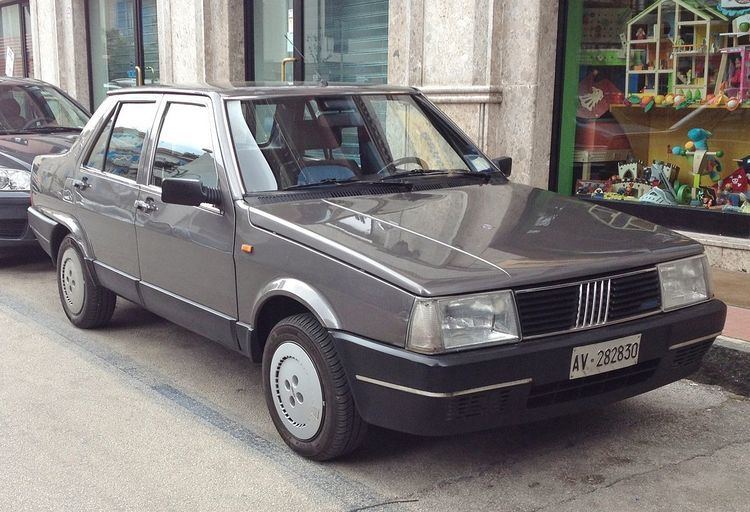Manufacturer Fiat Class Small family car | Production 1983-1990 | |
 | ||
Body style 4-door saloon5-door estate"Weekend" | ||
The Fiat Regata is an automobile produced by Italian automaker Fiat from 1983 to 1990. The Regata name was used for the sedan and station wagon versions of the Fiat Ritmo hatchback, corresponding to the post-facelift Ritmo. The Regata was offered with a choice of three gasoline and two diesel engines.
Contents
Spanish builder SEAT created a similar saloon car from Ritmo underpinnings called the SEAT Málaga. Nevertheless, development for the two cars was separate.
1983
The Regata, unveiled at the Frankfurt Motor Show in September 1983, was developed from the pre-facelift Ritmo (which had been known in United Kingdom and United States markets as the Fiat Strada) and utilised almost all the mechanicals, although the wheelbase was stretched slightly. A conventional four-door three-box design, it bore very little external resemblance to the original Ritmo although it hinted strongly at the look of the 1982 facelift for that car. In the Swedish market the car was called "Regatta", as Regata was uncomfortably close to a derogatory term for an overbearing woman. The same name was used in Latin American markets.
The engines offered were also similar, being the 1,301 cc inline-four rated at 68 PS (50 kW; 67 hp) (Regata 70) and the 1,498 cc I4 rated at 82 PS (60 kW; 81 hp) (Regata 85). Both of these were SOHC engines. A DOHC 1,585 cc I4 rated at 100 PS (74 kW; 99 hp) (Regata 100) was also available with two SOHC diesels, a 1,714 cc straight-four rated at 58 PS (43 kW; 57 hp) (Regata D) and a 1,929 cc straight-four rated at 65 PS (48 kW; 64 hp) (Regata DS), the latter of which was added in 1984. An economy model called the "ES" ("Energy Saving") was also available, it featured an early start-stop system. It featured some detail modifications to the aerodynamics, an optimised (higher compression ratio and different valve timing) 1,301 cc engine (rated at 65 PS (48 kW; 64 hp)), an engine shut-off system (when idling) and electronic ignition. Aside from the lowest-priced versions, a five-speed manual transmission came as standard.
The Regata Weekend estate was introduced in November 1984. It was available with the 1.3 L or 1.6 L engines and both diesel engines. The Weekend replaced the 131 Panorama, which had been kept in production alongside the Regata. It featured a folding rear bumper, enabling easier access to the load area. The suspension and brakes were uprated to cope with the extra weight. Alongside there was also a two-seater Van derivative called the Marengo, only available with the larger diesel engine.
1986
A mid-life update was carried out in 1986, in which numerous small details were changed, most notably new doors with an altered window line. New door handles, grille, bumpers and wheel trims also featured. The 1,585 cc engine gained fuel injection to become the 100S i.e. (also available with a catalytic converter, losing some power and becoming the 90i.e.) whilst a catalysed and fuel-injected 1,498 cc unit powered the 75i.e. The 85 Automatic was also replaced by the 70 Automatic with a 1.3 litre engine rated at 65 PS (48 kW; 64 hp).
The diesel-powered models also changed slightly. An 80 PS (59 kW; 79 hp) 1,929 cc turbodiesel engine was introduced (badged Regata Turbo DS) whilst the 1,714 cc unit dropped in capacity to 1,697 cc (but gained power to 60 PS (44 kW; 59 hp) and had reduced fuel consumption). This model was simply badged as the Regata D. The weight was also reduced slightly.
Production ceased in 1990, when the Tempra was introduced.
Sevel production
The Regata started production by Sevel in Argentina in 1985, where production continued until 1995. As in Sweden, the car was called the Regatta in Latin America. Unlike its European sisters, the car was considered somewhat upmarket in Latin America. The Regatta 85 received a 82 hp (61 kW) 1.5 litre, while a 100S came with a 100 hp (75 kW) 1.6-litre version. Along with a 1987 facelift, the 2000 Twincam replaced the 100S, carrying the same level of equipment but with a larger Twin Cam 2 litre engine with 10 more hp and considerably more torque. The 2000 managed the 0–100 km/h sprint in 9.8 seconds and had a rear spoiler. The Regatta 85 changed names, becoming the Regatta 1.5 S (Super) and SC (Super Confort).
A more thorough facelift in 1988 produced the Regatta Edición II. The engines remained the same until the 1990 model year, when both engines were replaced by the 87 hp (65 kW) 1,581 cc engine from the Fiat Tipo. Later a cheaper 1.4 S using the 1,372 cc Tipo engine, with 63 hp (47 kW), was added to the line-up. Production ended in 1995 as the Regata was replaced by the Tempra in Latin America as well. The Regatta Weekend (Station Wagon) was also produced in Argentina between 1986 and 1992, only available with the 1.5 or Tipo 1.6 engines.
Movie roles
The Regata featured strongly in the 1986 film Gung Ho, centred on a (fictional) Japanese auto manufacturer reopening a shutdown automobile factory in a fictional western Pennsylvania town, the main model produced by "Assan Motors" were in fact Fiat Regatas (and Fiat 147s) in various stages of completion. The factory shots took place in the Fiat plant in El Palomar, Argentina.
The Regata was also featured in National Lampoons European Vacation. When the Griswolds go to Rome, they rent a car unknowingly from 2 crooks who just hid the travel agency clerk in the trunk of said vehicle.
Scale models
Polistil manufactured a 1/25 and a 1/41 scale diecast Regata. A 1/43 variant of this car was made by Bburago, Norev (for Hachette Fiat Story) and Elite Models.
